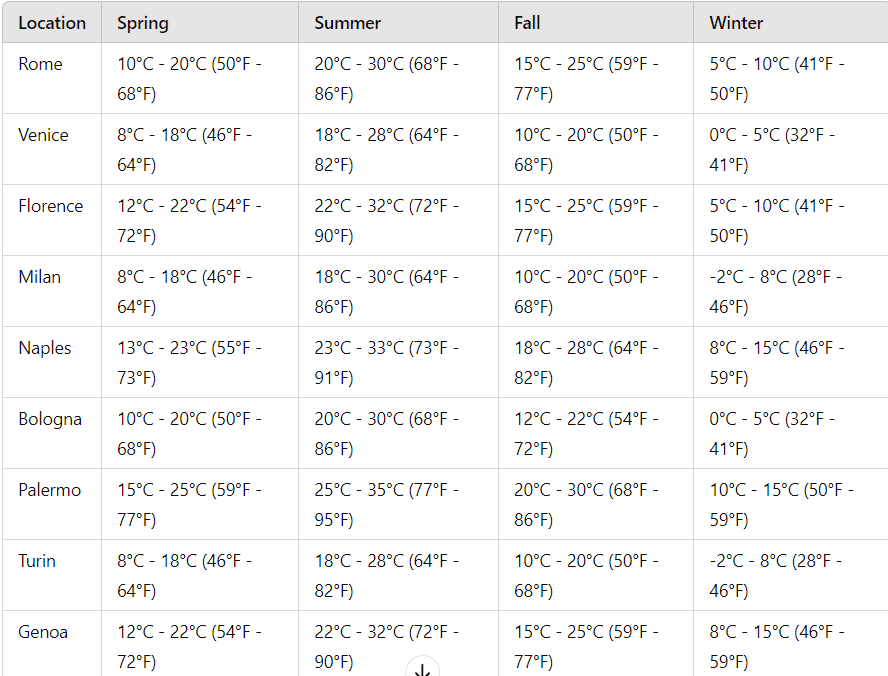Before Your Trip to Italy
Planning your upcoming journey to Italy and feeling uncertain about what to expect? We’ve anticipated all your potential queries to help you navigate every aspect before you embark on your adventure. Whether you’re curious about visa requirements, what essentials to pack, cultural norms to observe, or how to access emergency assistance, we’re here to ensure you feel informed and ready for an incredible experience. Let’s explore these details together so you can feel fully prepared and excited about your upcoming visit to Italy.
The Weather in Italy

Summer in Italy can be quite intense, with temperatures often reaching 100°F (38°C), especially in southern regions like Sicily and Calabria. It’s still a great time to visit if you prepare properly for the heat. Make sure to bring UV umbrellas, sunscreen, and stay hydrated. However, some places, like Rome and Florence, can feel unbearably hot between 12 PM and 5 PM during peak summer.
Winter can bring cold weather and snow to certain areas, particularly in the northern regions and mountainous areas like the Alps and Dolomites. It’s considered the low season for tourism, running from November through March.
Spring is a wonderful time to visit, as everything is in full bloom and the weather is pleasant without being too hot. April and May are ideal months to explore Italy, with comfortable temperatures and fewer tourists.
Fall, particularly September and October, is another excellent time to visit. The weather remains warm, but the crowds are smaller, and temperatures are generally mild across the country. This is an ideal time to enjoy the beauty of Italy’s landscapes and cities without the summer rush.
How to Dress in Italy – Seasonal Considerations
Summer

During the summer months in Italy, the heat can be quite intense, especially in southern regions like Sicily, where temperatures can reach up to 40°C with high humidity. Lightweight clothing such as sleeveless tops and shorts are generally acceptable to stay cool, but it’s advisable to choose styles that are modest and not overly revealing. However, keep in mind that not all regions of Italy experience such extreme heat, so dress according to the specific climate of your destination.
Fall
Fall in Italy brings a mix of temperatures, with warm days and cooler evenings. Layering is key to adjust to these fluctuations throughout the day. It’s interesting how the sun can make daytime feel warmer than it actually is, while evenings tend to cool down noticeably. Additionally, fall tends to be rainier than spring, so having a good quality raincoat handy is advisable to stay dry during occasional showers.
Winter
Winter in Italy is typically the wettest season, characterized by varying temperatures depending on your location. Coastal areas generally experience milder winters compared to inland regions, where temperatures can drop significantly. Packing warm clothes is essential, along with a sturdy raincoat to cope with frequent rainfall. Whether you’re exploring coastal cities or venturing inland, being prepared for chilly and wet conditions will ensure a comfortable winter experience in Italy.
The Currency in Italy

Italy operates using the Euro (EUR or €) as its official currency. For travelers heading to this beautiful destination, knowing how to manage currency exchanges is essential.
Which Currency Can Tourists Use in Italy?
While some businesses in tourist areas might accept US Dollars or British Pounds, the Euro is the widely preferred currency for transactions. It’s recommended to have Euros on hand to avoid any inconvenience, especially in more local or non-touristy establishments.
Where to Exchange Money in Italy
Tourists can exchange their currency into Euros at several locations:
Banks: Most banks in cities and towns offer currency exchange services. They provide reliable rates and are generally a secure option.
Authorized Exchange Offices: These offices are also available in urban areas and offer competitive rates. They are convenient for travelers needing to exchange cash.
ATMs: Foreign visitors can withdraw Euros directly from ATMs using their international debit or credit cards. This method is convenient and ensures access to local currency as needed.
Tips for Exchanging Money in Italy
- Exchange rates at airports, hotels, and tourist areas are usually less favorable. Try to exchange money in city centers for better rates.
- Before exchanging large amounts of money, compare the rates offered by different banks or exchange offices. Small differences can add up, especially for larger amounts.
- Use a money belt or a secure wallet to protect your cash and cards from pickpockets, especially in crowded tourist areas.
- Italian banks generally offer reliable exchange rates and are a secure option for currency exchange.
The Language in Italy
In Italy, English is spoken more commonly in major tourist areas and cities like Rome, Florence, and Venice. However, outside of these hotspots, in rural regions and smaller towns, you might find fewer people who speak English fluently. This can make everyday activities such as ordering food, asking for directions, or shopping a bit challenging. Learning a few basic Italian phrases can be incredibly helpful and is often appreciated by locals. Additionally, carrying a phrasebook or using a translation app can ease communication barriers significantly.
In popular tourist destinations, English is more widely understood, especially in hotels, restaurants, and shops that cater to visitors. However, having some knowledge of Italian can still enhance your interactions and experiences. Italians generally appreciate efforts to speak their language, and even simple phrases can go a long way. Using gestures and being patient can also help bridge the language gap, ensuring a smoother and more enjoyable experience while traveling in Italy.
The Necessary Documents and Emergency Contacts
Visa and Passport
Visa requirements for Italy vary depending on the nationality of the visitor. Citizens of some countries may enter Italy and stay within the Schengen Area for up to 90 days within a 180-day period without a visa, while others may require a visa. It is advisable to check with the Italian consulate or embassy in your home country for specific visa requirements before your trip. Additionally, ensure that your passport is valid for at least three months beyond your planned departure date from the Schengen Area.
Travel Insurance
You must have travel insurance with a minimum medical, evacuation and repatriation coverage of US$50,000 covering all applicable dates of travel with the Tour Operator. This insurance must cover personal injury and emergency medical expenses. On the first day of each Tour, a representative of the Tour Operator will verify that you have sufficient insurance in place. You are strongly recommended to extend your coverage to include cancellation, curtailment, and all other expenses that may arise as a result of loss, damage, injury, delay or inconvenience while traveling. You acknowledge that insurance coverage is not included in the cost of any Tour offered by the Tour Operator, and you are required to obtain separate coverage at an additional cost. It is your responsibility to ensure that you have sufficient coverage and comply with the terms of the applicable insurance plans. You are responsible for advising your insurer of the type of travel, destination(s) and activities included in your booking so that the insurer may provide appropriate coverage.
Travel Vaccines for Italy
The CDC and WHO recommend the following vaccinations for Italy: hepatitis A, polio, chikungunya, tick-borne encephalitis, rabies, hepatitis B, influenza, COVID-19, pneumonia, meningitis, chickenpox, shingles, Tdap (tetanus, diphtheria and pertussis) and measles, mumps and rubella (MMR).
Essential Emergency Numbers in Italy

When visiting Italy, it is important to be aware of the emergency contact numbers for your safety and peace of mind. Here are the key emergency numbers you should know:
Police: Dial 112 or 113 for any police assistance. They can help with issues ranging from theft to lost property.
Ambulance: Dial 118 if you need medical assistance or an ambulance. This number is crucial for any health emergencies.
Fire Department: Dial 115 in case of a fire or related emergencies. The fire department can handle various types of fire incidents.
Vegetarian, Vegan, and Gluten-free Eating in Italy

Italy is a haven for vegetarians, with its cuisine featuring a plethora of vegetable-based dishes, including a wide variety of pasta, risottos, and salads. However, as a vegan tourist, you might encounter some challenges. Many Italian dishes include cheese, eggs, or other dairy products, so it’s important to clearly communicate your dietary restrictions to ensure meals meet your needs.
For those with gluten allergies, navigating Italian cuisine can be tricky since bread, pasta, and other wheat-based foods are central to many meals. Fortunately, gluten-free options have become more widely available, particularly in larger cities and tourist areas. Always specify your dietary requirements to restaurant staff to ensure safe and enjoyable dining experiences.
To make your trip smoother, it’s advisable to save emergency contact numbers on your phone. Having these numbers handy can be crucial in critical situations, ensuring you receive prompt assistance when needed. Enjoy your Italian adventure with confidence, knowing you’re well-prepared for any dietary or emergency needs.
Do’s and Don’ts in Italy
Do’s
- Do keep your voice low and your cellphones turned off when visiting churches and museums in Italy. Speaking in whispers is encouraged in these places and keeping quiet is even better.
- Do make an attempt to learn and speak the language. Italians like it when you make an attempt to integrate into their culture.
- Do plan your days to include only a few sights at a time. To fully enjoy Italy, you must savor it to fully appreciate it.
- Do try to look as trendy as possible. Dress to impress if you want to blend in with the natives. Italians take tremendous pride in their fashion sense, therefore getting prepared to go out is common here.
- Do use Signora and Signore combined with their last name.Shake their hand while greeting them and recognizing the introduction.
Don’ts
- Don’t cut spaghetti! In Italy, cutting spaghetti is generally frowned upon and considered improper table etiquette, especially among traditionalists.
- Don’t put cheese on a pasta that contains fish or seafood
- Don’t disrespecting in religous sites
- Don’t address someone you just met by their first name.First names are only used when you are close to someone or when they specifically request it.
- Don’t assume that all establishments in Italy take credit cards; however, many restaurants and retailers do.
- Don’t eat anything when visiting the country’s museums and churches. If you truly need to eat, excuse yourself and leave the building to obtain some food.
What to Pack for Italy
Travel Adapter for Italy
In Italy, you will need a type C, F, or L power plug socket, with a standard voltage of 230V. Bringing a compatible travel adapter from home is crucial to ensure your electronics work smoothly. While basic converters can be purchased locally for a few euros, they are often uncomfortable and unreliable. It’s best to bring a reliable adapter from home.
Wifi Access and Mobile Connectivity in Italy
Staying connected in Italy can be relatively straightforward, but there are some considerations. Many public WiFi spots, including those at major airports like Rome Fiumicino, require you to register with a phone number. This can be inconvenient if you don’t have an Italian number.
Consider getting an international phone plan before your trip or purchasing an Italian SIM card upon arrival. If you choose the latter, remember to bring a SIM card ejector tool. Alternatively, newer phones (from around 2020 onwards) might support eSIMs, which can be downloaded directly to your device without needing to physically change SIM cards. This is a convenient way to maintain connectivity during your travels.
In Your Suitcase
- Modest Attire: Long pants or skirts, scarves, and shirts with sleeves for visiting religious sites like the Vatican.
- Lightweight Clothing: For warm weather, including T-shirts, shorts, and summer dresses.
- Layers: Sweaters or jackets for cooler evenings or trips to the Alps.
- Swimwear: For beach trips to the Amalfi Coast or hotel pools.
- Comfortable Walking Shoes: Essential for exploring cities like Rome and Florence.
- Sandals: For warmer weather and coastal outings.
- Hiking Boots: If you plan on exploring mountainous regions or trails.
- Toiletries: Including toothpaste, toothbrush, shampoo, and conditioner.
- Insect Repellent: To protect against bugs, especially in rural areas.
- Travel-Size Detergent: For laundry on-the-go.
- Electronic Devices: Smartphone, camera, chargers, and adapters.
- Health Essentials: Vitamins and probiotics to stay healthy.
- Small Travel Pillow: For comfort during long journeys or breaks.
In Your Daypack
- Hand Sanitizer: For maintaining hygiene.
- Prescription Medications: Any necessary medical supplies.
- Power Bank: For charging devices on-the-go.
- Travel Documents: Passport, visa (if required), and travel insurance documents.
- Sun Protection: Sunglasses, sunscreen, and a sunhat.
- Light Jacket: In case it gets chilly or if there’s unexpected weather.
- Camera: For capturing memorable moments.
- Collapsible Walking Stick: Support for hiking or uneven terrain.
Being well-prepared with the right items will ensure a comfortable and enjoyable experience while traveling through the beautiful landscapes and historic cities of Italy.










